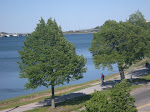 ice formations to form on the surface of this tidal basin so we are frozen over from shoreline to mid-bay. One doesn't walk on this ice as the continual ebb and flow of the tide creates ice pilings rather then a smooth, thick surface. We are experiencing a winter-winter this year! That means temperatures have remained consistently cold so that the snow remains on the ground rather than being washed away by rain or solar heat.
ice formations to form on the surface of this tidal basin so we are frozen over from shoreline to mid-bay. One doesn't walk on this ice as the continual ebb and flow of the tide creates ice pilings rather then a smooth, thick surface. We are experiencing a winter-winter this year! That means temperatures have remained consistently cold so that the snow remains on the ground rather than being washed away by rain or solar heat.Our friends the ducks look like black lava rocks dropped on big chunks of white. Not much paddling in the open waters. But they
 do continue to march up the duck channel with
do continue to march up the duck channel with the rising tide and leave for open waters as the tide recedes. There continues to be ever changing life along the foot path. Due to the treacherous conditions, we will explore the winter shore line as the Canada goose does, from above, in V formation. Visibility is as far as the eye can see on this crisp blue, blue sky day. No discernible wind so the gliding will be smooth and easy. Let's not ruffle our feathers. Come on, let's take off.
the rising tide and leave for open waters as the tide recedes. There continues to be ever changing life along the foot path. Due to the treacherous conditions, we will explore the winter shore line as the Canada goose does, from above, in V formation. Visibility is as far as the eye can see on this crisp blue, blue sky day. No discernible wind so the gliding will be smooth and easy. Let's not ruffle our feathers. Come on, let's take off.Flying counter-clockwise, we're launching from the duck channel directly in front of my home situated on the mid-south shore. Baxter Boulevard separates the shoreline on our right from the embankment on the left which borders the south, west and north corridors. The eastern arm, or Bayside, is a combination of noisy Interstate 295 and large sports fields.
Our journey has us exploring only the water line as the bird flies. Marsh grass grows along the southern, western and north western shores. In addition to the southern duck channel, a stream flows into the cove due west and another urban drain is due north. These areas are the favored locations for water fowl congregations...moving with the ebb and flow of the tides. Morning finds them resting and feeding on the southern shore while mid-day and afternoon they fancy the bay, either due west or north. Could it be the waterfront afternoon breeze that draws them to these locations?
Continuing in flight we find beach terrain on the northeast and eastern shores. About a hundred feet off the northeastern beach is a bird rock where seagulls flock. It was on this rock that a bald eagle landed on November 30, 2006. Why do I recall the specifics. It was the day I found my new home. Driving the Boulevard, listening to Rachmaninoff's Concerto in C Minor, spotting the eagle...the future was feeling very good. OOPS. I digress.
On the eastern beach is an ever changing rock sculpture garden built by one of Portland's many unidentified artists. I am in awe of our own mini Stonehenge.
 Five, six, seven rocks precariously balanced on one another surviving the forces of nature. Sometimes one falls to a northwest blow or vandals, but another is quickly erected and the sculpture garden evolves. Like the tides, it has an ebb and flow.
Five, six, seven rocks precariously balanced on one another surviving the forces of nature. Sometimes one falls to a northwest blow or vandals, but another is quickly erected and the sculpture garden evolves. Like the tides, it has an ebb and flow.Coming around we now glide over the southeastern beach which is adjacent to the Back Cove parking lot. Bustling activity here with cars coming and going so it's only foraging seagulls frequenting these grounds. Anything for a scrap.
Although the cove formation is square, the scalloped edge and meandering foot path creates a rounder appearance. Our journey seems as though we are circling, always banking to the right. (That's flight speak.)
Tides in the Back Cove range from a high of 10.4 feet during the new and full moons to a low of
-8 feet during less extreme lunar phases. On average, the tide change is 8.5 feet. At low tide the bay appears to be one very large clam flat with a small channel, drawing 4 feet, leading to the open ocean. This lack of draw keeps the area pretty much boat free, although during the summer a lobster man sets a few traps in the southeastern quadrant. Hauling the traps is subject to tides. I believe Frederic Law Olmsted, designer of Portland's park system in the 1870's, would like knowing that the Back Cove is an estuary for ducks, geese, herons, egrets and the occasional bald eagle.
As we glide back towards the southern shore duck channel, I am aware of more details to describe. Those will have to wait until the foot path is passable or the great Snow Goose comes
 and sweeps me off my feet.
and sweeps me off my feet.
